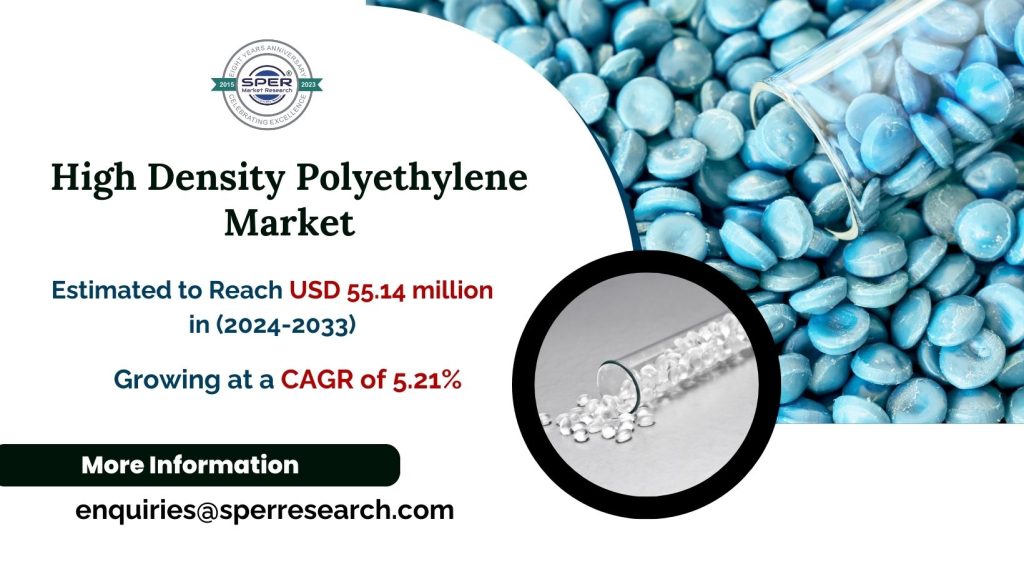High Density Polyethylene Market Share, Revenue, Emerging Trends, Growth Drivers, Challenges, Opportunities and Forecast Till 2033: SPER Market Research

An ethylene monomer-based thermoplastic polymer is called high-density polyethylene. Ethylene polymerization in gas phase can be used to create HDPE. Petroleum is used for “cracking,” which is the process of applying high heat under regulated conditions. Consequently, ethylene gas is produced. The final result of polymerizing these ethylene molecules is HDPE. It can also be made in a number of ways, such as using Ziegler-Natta catalysis. High-density polyethylene (HDPE) is tough, opaque, and heat-resistant in addition to being chemically resistant. HDPE has an exceptional strength-to-density ratio, which contributes to its versatility. HDPE is used to make a wide variety of goods, including as bottles, seats, pipes, temporary costumes, and kid’s toys. Other goods manufactured of HDPE include injection-molded food containers, oil bottles, blow-molded industrial and household bottles, and high-performance pipes.
According to SPER market research, ‘High Density Polyethylene Market Size- By Product Type, By End User, By Deployment- Regional Outlook, Competitive Strategies and Segment Forecast to 2033’ state that the Global High Density Polyethylene Market is predicted to reach 55.14 million by 2033 with a CAGR of 5.21%.
Because of its exceptional strength, chemical resistance, and durability, HDPE is widely used in the packaging industry for products including bottles, containers, and films. The growing need for packaged goods, especially in the food and beverage, pharmaceutical, and personal care sectors, is driving the growth of the HDPE market. In addition, the construction industry uses a lot of HDPE pipes for sewage, drainage, and gas distribution systems. The need for HDPE pipes is being driven by rising rates of urbanization and infrastructure development in emerging nations, which is boosting the HDPE market. Additionally, HDPE products address consumers’ expectations for long-lasting, ecologically responsible products by providing simplicity of use, durability, and safety. The need for HDPE packaging solutions is driven by this consumer trend in a number of end-use industries.
Because it costs more to make high-density polyethylene, the finished product costs more. Second, the raw materials needed to make high-density polyethylene are highly expensive. Producing these materials involves highly specialized individuals since they demand exact temperature adjustments during the manufacturing process. As of yet, there is no substitute that can bring down the price of making high-density polyethylene. The manufacture of high-density polyethylene is energy-intensive and emits a large amount of carbon dioxide, a greenhouse gas that is linked to climate change and global warming. Decades-long build up in landfills is caused by the high-density polyethylene’s slow breakdown. These are the primary challenges that will impact the market for high-density polyethylene during the projected time frame.
Request For Free Sample Report @ https://www.sperresearch.com/report-store/high-density-polyethylene-market.aspx?sample=1
Impact of COVID-19 on Global High Density Polyethylene Market
The COVID-19 pandemic affected the demand for HDPE differently throughout different value chains. While packaging remained in high demand, especially for food, medicine, and sanitary products, demand fell sharply in the automobile and construction sectors. The pandemic also led to an increase in healthcare-related and delivery services, which increased the need for HDPE packaging and positively impacted the expansion of the worldwide market. Moreover, the HDPE market participants have experienced a great deal of optimism due to the easing of stringent regulations and the acceleration of measures towards economic recuperation. Because of this, it is expected that the market would consistently grow on a global basis throughout the forecast years.
Asia Pacific was the biggest market for high-density polyethylene geographically. The Asia Pacific high-density polyethylene market was propelled by several reasons such as the expanding use of plastic pipes, a rise in building activities, and an increase in the demand for plastic bottles and containers in the food and beverage (F&B) sector. Significant competitors in the market also include The Dow Chemical Company, Chevron Phillips Chemical Company LLC, Dynalab Corp, Exxon Mobil Corporation, INEOS AG, and other well-known companies.
Global High Density Polyethylene Market Segmentation:
By Technology: Based on the Technology, Global High Density Polyethylene Market is segmented as; Injection Moulding, Profile Extrusion, Film and Sheet Extrusion, Pipe Extrusion, Blow Molding, Others.
By Application: Based on the Application, Global High Density Polyethylene Market is segmented as; Pipes & Tubes, Rigid Articles, Sheet and films, Caps & Closures, Geomembranes, Others.
By End User: Based on the End User, Global High Density Polyethylene Market is segmented as; Packaging, Transportation, Electrical and Electronics, Building and Construction, Agriculture, Industry and Machinery, Others.
By Sales Channel: Based on the Sales Channel, Global High Density Polyethylene Market is segmented as; Direct Sale, Indirect Sale.
By Region: This research also includes data for North America, Asia-Pacific, Latin America, Middle East & Africa and Europe.
This study also encompasses various drivers and restraining factors of this market for the forecast period. Various growth opportunities are also discussed in the report.
For More Information, refer to below link:-
High Density Polyethylene Market Outlook
Related Reports:
Follow Us –
LinkedIn | Instagram | Facebook | Twitter
Contact Us:
Sara Lopes, Business Consultant – USA
SPER Market Research
+1–347–460–2899





